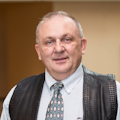
Although the biannual International Laser Technology Congress AKL, held in Aachen from May 7-9, is in principle international, in reality, the overwhelming majority of participants are from Germany, and the talks are mostly in German (with simultaneous translation). As noted in David Belforte’s blog on the show, the most highly touted talks were on USP (ultra-short pulse) lasers and applications and on LAM (laser additive manufacturing).
The conference is expensive at over 500 Euros per day for the three days of sessions, but anyone with serious interest in the current state of the art and future of the laser industry can justify this expense with all of the information available and the contacts that can be made. Note also that the days are planned with activities from 8 am until 11 pm with very minor breaks in between, considering the talks, vendor programs, meetings, and social gatherings in the evening. Therefore, the day is really packed with a full schedule—and if anything else needs to be done during these three days, it is almost required to break away for a bit.
The first day is devoted to talks and discussions on Laser Basics, business opportunities, and round-table discussions. In the evening of the first day, the Technology Awards banquet was held in the beautiful Coronation Hall of Charlemagne in downtown Aachen. The meat of the conference is the technical talks given the second and third days as well as the opportunity to interact with laser and electro-optic vendors. A highlight of the conference is the visit to Fraunhofer ILT (Industrial Laser Technology) laboratories to see actual demonstrations. Over 80 stations were set up involving lasers used for a dizzying array of applications including welding, cladding, melting, micromachining, lithography, software, surgery, and the list goes on and on ….
Now, let’s discuss the role played by institutes like Fraunhofer and others. Basic research is carried out in universities and institutes like Max Plank. This research is very basic and need not be applied at all and is usually performed in technology roadmap steps 1-3, involving the research phase. Fraunhofer Institutes exist to bridge the gap from basic to applied research and usually gets involved in steps 4-7 by working with both basic research and also with industry to bring new technologies to manufacturing. Steps 8-10 are usually reserved for private industry. So, in principle, Fraunhofer Institutes do not make products, but they are a resource for proving and improving concepts, for training students in new technologies, and also for incubating new companies that can carry forward the commercialization of new processes.
Unfortunately, the US does not have anything even remotely resembling this type of technology promotion, while Germany has not only the Fraunhofer Institutes, but also laser centers of excellence in Hanover, Dresden, Bavaria, and probably a few others.
How is it that the US does not invest in this technology when 'light' has changed and is changing the way we all live in very profound and fundamental ways? How is it that Germany currently gets about 25% of its energy from renewable sources like solar?
Unfortunately, the US government and most industries are not investing in REAL long term opportunities. I am not talking about the highly publicized things like Solara, where the money is invested foolishly for political purposes, but rather with a real long-term plan in place with defined technological roadmaps. This is something that really needs to be changed if possible.
I am always interested in hearing your thoughts concerning laser micromachining, the laser industry, comments on entrepreneurial endeavors, etc. AND … we are always looking for fresh, publishable material. Please feel free to contact me at [email protected].
About the Author
Ron Schaeffer
Ron Schaeffer, Ph.D., is a blogger and contributing editor, and a member of the Laser Focus World Editorial Advisory Board. He is an industry expert in the field of laser micromachining and was formerly Chief Executive Officer of PhotoMachining, Inc. He has been involved in laser manufacturing and materials processing for over 25 years, working in and starting small companies. He is an advisor and past member of the Board of Directors of the Laser Institute of America. He has a Ph.D. in Physical Chemistry from Lehigh University and did graduate work at the University of Paris. His book, Fundamentals of Laser Micromachining, is available from CRC Press.
